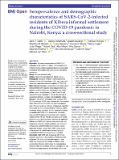Seroprevalence and demographic characteristics of SARS-CoV-2-infected residents of Kibera informal settlement during the COVID-19 pandemic in Nairobi, Kenya: a cross-sectional study
Publication Date
2025-03-07Type
Article, Journalviews
downloads
Metadata
Show full item recordCitation
TY - JOUR AU - Carter, Jane AU - Khamadi, Samoel AU - Mwangi, Joseph AU - Muhula, Samuel AU - Munene, Stephen AU - Kanyara, Lucy AU - Kinyua, Joyceline AU - Lagat, Nancy AU - Chege, Judy AU - Oira, Robert AU - Maiyo, Alex AU - Stewart, Roy AU - Postma, Maarten AU - Stekelenburg, Jelle AU - Osur, J. AU - Hulst, Marinus PY - 2025/04/02 SP - e094546 T1 - Seroprevalence and demographic characteristics of SARS-CoV-2-infected residents of Kibera informal settlement during the COVID-19 pandemic in Nairobi, Kenya: a cross-sectional study VL - 15 DO - 10.1136/bmjopen-2024-094546 JO - BMJ Open ER -
Abstract/
Objectives To assess the prevalence of SARS-CoV-2 antibodies in the residents of Kibera informal settlement in Nairobi, Kenya, before vaccination became widespread, and explore demographic and health-related risk factors for infection. Design A cross-sectional study. Setting Kibera informal settlement, Nairobi, Kenya. Participants Residents of Kibera informal settlement between October 2019 and August 2021, age 1 year and above who reported no current symptoms of COVID-19. Main outcome measures Associations were determined between SARS-CoV-2 positive tests measured with one rapid test and two ELISAs and demographic and health-related factors, using Pearson’s χ ² test. Crude OR and adjusted OR were calculated to quantify the strength of associations between variables and seropositive status. Results A total of 438 participants were recruited. Most (79.2%) were age 18–50 years; females (64.2%) exceeded males. More than one-third (39.1%) were unemployed; only 7.4% were in formal, full-time employment. Less than one-quarter (22.1%) self-reported any underlying health conditions. Nearly two-thirds (64.2%) reported symptoms compatible with COVID-19 in the previous 16 months; only one (0.23%) had been hospitalised with a reported negative COVID-19 test. 370 (84.5%) participants tested positive in any of the three tests. There was no significant difference in SARS-CoV-2 seropositivity across age, sex, presence of underlying health conditions, on medication or those ever tested for SARS-CoV-2. Multiple logistic regression analysis showed that COVID-19 symptoms in the previous 16 months were the only significant independent predictor of seropositivity (p=0.0085). Conclusion High SARS-CoV-2 exposure with limited morbidity was found in the residents of Kibera informal settlement. The study confirms other reports of high SARS-CoV-2 exposure with limited morbidity in slum communities. Reasons cited include the high infectious disease burden on the African continent, demographic age structure and underreporting due to limited testing and lack of access to healthcare services; genetic factors may also play a role. These factors require further investigation.

